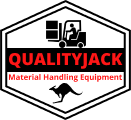You have no items in your shopping cart.
Best Ways To Reduce Workplace Injuries
Warehouses are one of the most common environments for workplace injuries, with heavy equipment such as forklifts and pallet jacks being used daily. Employees can often be working with hazardous materials as well, making the risks even higher.
However, by practicing proper manual handling procedures with the correct equipment, employers can significantly reduce the amount of injuries and accidents to their staff.
1. Practice Safe Lifting
It’s important to make sure your staff are protecting their backs and muscles from injury when lifting heavy or awkward items. Back injuries from improper lifting account for a large percentage of workplace injuries and accidents.
Using mechanical aids, such as forklifts and storage conveyors to lift stock to mezzanine levels will reduce the risk of injury significantly. Manual handling equipment is there to help us eliminate or reduce manual effort in the workplace, while boosting productivity and ensuring workplace safety.
Have your staff members take a course in proper lifting procedures and processes to educate them on looking after their bodies at work. Also ask them for input on making their day to day work duties easier to perform with less risk involved.
2. Keep Walkways and Floors Clear and Safe
Slips and falls are one of the most common workplace accidents and cause of injury. These can be caused by slippery surfaces, untidy work environments, lack of signage and poor lighting.
Reducing risk is usually straightforward if you act quickly to mop up spillages, repair broken steps and encourage staff to report maintenance faults straightaway. Use signage and bollards to create safe and secure work areas, and ensure all warehouse floors are free of hazards. Mark out any areas and pathways that employees are to avoid.
Display safety information clearly, for example, directions to emergency exits and warnings about moving vehicles across pathways.
3. Manage Hazardous Materials Safely and Correctly
Warehouses can be full of hazardous area or items. Ensure staff receive training in the correct handling and disposal techniques for hazardous materials. Make sure any potential areas or materials of concern are marked with the proper signage and instructions.
As a business owner, consider ethical disposal methods for hazardous waste items to protect the environment and make your business more eco-friendly.
4. Protect Staff from Falls
Falls from ladders or scaffolding account for many workplace injuries. If you have a storage area that includes high shelving, ensure that you have a safe ladder or step stool available so that you or your staff members are not forced to climb on boxes or on objects to retrieve items.
Make sure all ladders are in proper working order and that staff know how to use them correctly, including locking mechanisms. Regularly inspect scaffolding and mezzanine floors for maintenance or repairs.
5. Meet Fire Safety Standards
Protect your premises and your staff against possible fire scenarios.
Make sure you have smoke detectors installed, with reliable working batteries. Carry out regular fire safety risk assessments and maintain a fire management plan that identifies possible hazards. Typical workplace breaches can include blocking fire exits, propping open fire doors and failing to train staff in evacuation procedures.
Best Ways To Reduce Workplace Injuries
Warehouses are one of the most common environments for workplace injuries, with heavy equipment such as forklifts and pallet jacks being used daily. Employees can often be working with hazardous materials as well, making the risks even higher.
However, by practicing proper manual handling procedures with the correct equipment, employers can significantly reduce the amount of injuries and accidents to their staff.
1. Practice Safe Lifting
It’s important to make sure your staff are protecting their backs and muscles from injury when lifting heavy or awkward items. Back injuries from improper lifting account for a large percentage of workplace injuries and accidents.
Using mechanical aids, such as forklifts and storage conveyors to lift stock to mezzanine levels will reduce the risk of injury significantly. Manual handling equipment is there to help us eliminate or reduce manual effort in the workplace, while boosting productivity and ensuring workplace safety.
Have your staff members take a course in proper lifting procedures and processes to educate them on looking after their bodies at work. Also ask them for input on making their day to day work duties easier to perform with less risk involved.
2. Keep Walkways and Floors Clear and Safe
Slips and falls are one of the most common workplace accidents and cause of injury. These can be caused by slippery surfaces, untidy work environments, lack of signage and poor lighting.
Reducing risk is usually straightforward if you act quickly to mop up spillages, repair broken steps and encourage staff to report maintenance faults straightaway. Use signage and bollards to create safe and secure work areas, and ensure all warehouse floors are free of hazards. Mark out any areas and pathways that employees are to avoid.
Display safety information clearly, for example, directions to emergency exits and warnings about moving vehicles across pathways.
3. Manage Hazardous Materials Safely and Correctly
Warehouses can be full of hazardous area or items. Ensure staff receive training in the correct handling and disposal techniques for hazardous materials. Make sure any potential areas or materials of concern are marked with the proper signage and instructions.
As a business owner, consider ethical disposal methods for hazardous waste items to protect the environment and make your business more eco-friendly.
4. Protect Staff from Falls
Falls from ladders or scaffolding account for many workplace injuries. If you have a storage area that includes high shelving, ensure that you have a safe ladder or step stool available so that you or your staff members are not forced to climb on boxes or on objects to retrieve items.
Make sure all ladders are in proper working order and that staff know how to use them correctly, including locking mechanisms. Regularly inspect scaffolding and mezzanine floors for maintenance or repairs.
5. Meet Fire Safety Standards
Protect your premises and your staff against possible fire scenarios.
Make sure you have smoke detectors installed, with reliable working batteries. Carry out regular fire safety risk assessments and maintain a fire management plan that identifies possible hazards. Typical workplace breaches can include blocking fire exits, propping open fire doors and failing to train staff in evacuation procedures.









